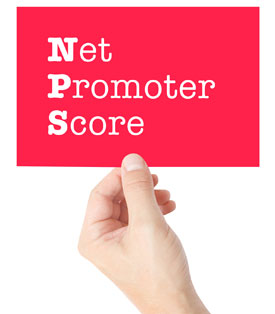Analysis shows companies that achieve long-term profitable growth have Net Promoter Scores two times higher than the average company. Learn more about the NPS system in this quick guide.
 As a business owner or executive with high hopes of your company being around a long time, you often find yourself wondering what customers think about the products and services your company offers.
As a business owner or executive with high hopes of your company being around a long time, you often find yourself wondering what customers think about the products and services your company offers.
You need a way to measure customer satisfaction and loyalty, a way that produces actionable results. There is a way, and it’s known as net promoter score (NPS).
The NPS is an excellent tool for measuring satisfaction and loyalty among both regular customers and those that only utilise products and services occasionally. When coupled with targeted surveys, the NPS can transform a company from one that is barely keeping pace to one that is leading the industry.
The Basics of NPS
If you’re new to the concept, your first question is undoubtedly: what is NPS? The NPS, or Net Promoter Score, is a scientific measurement of customer satisfaction and loyalty developed by Bain & Company in the early 2000s. It’s based on the following question:
How likely are you to recommend our products or services to others?
Customers are asked this question, or something similar, and encouraged to respond by using a scale from 0 to 10. Customers who rate the company at six or less are known as ‘detractors’; those who rate the company either a 7 or 8 are known as ‘passives’; those who rate the company at either 9 or 10 are considered ‘promoters’.
The scale between the total percentages of detractors versus the total percentage of promoters is often referred to as the ‘spectrum’. Subtracting the total percentage of detractors from the total percentage of promoters results in a company’s net promoter score.
The strength of the NPS is its simplicity. Short NPS surveys tend to be very effective because:
- they don’t require an extensive time commitment from customers
- answering a single question, with perhaps a single follow-up, doesn’t seem like a burden to customers
- the less asked of customers in a survey situation, the more likely they are to complete the survey.
Calculating a company’s score is relatively straightforward. After sending out surveys and getting results back, you simply total up the percentage of promoters and detractors. Passives are irrelevant because they don’t have strong opinions one way or the other.
Let’s say survey responses indicate that 30% are promoters and 50% are detractors. We calculate an NPS of -20 by subtracting the percentage of detractors from the percentage of promoters. The worst possible score a company can get is -100; the best possible score is +100.
NPS is an effective tool that can be combined with others in the customer service toolbox to create the kind of experience that will result in ongoing satisfaction and future loyalty.
Surveys Tell the What and Why
In addition to the NPS is the customer survey. Surveys tell the ‘what’ and ‘why’ of scores. They tell companies just what their customers think about the overall experience and why they think it. This information is key to improving company performance so that it is always on an upward trajectory.
General guidelines for successfully surveying customers include:
- Gradually releasing surveys to targeted groups on a rolling schedule rather than all at once.
- Using both email and SMS to send survey invites. Avoid using language that could cause your invites to be caught by spam filters.
- Being sensitive to timing. For example, transactional surveys should go out as soon as possible after a transaction is complete.
- Being sensitive to frequency. Relationship surveys can be sent out quarterly or semi-annually; transactional surveys need to be sent out more frequently.
- Following up with customers, tracking survey result, and translating data into action.
NPS is a very good tool for finding out what customers think of your business and the services and products you offer. Used correctly and in conjunction with other tools, a company’s NPS score becomes a valuable metric that motivates better performance.
About the Author
Andy M Watson writes for Geckolyst. Geckolyst Analytics Engine helps you retrieve relevant insights and information from text-based conversations and other customer feedback responses.




